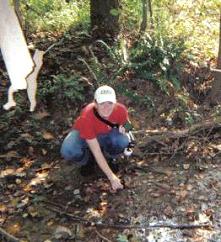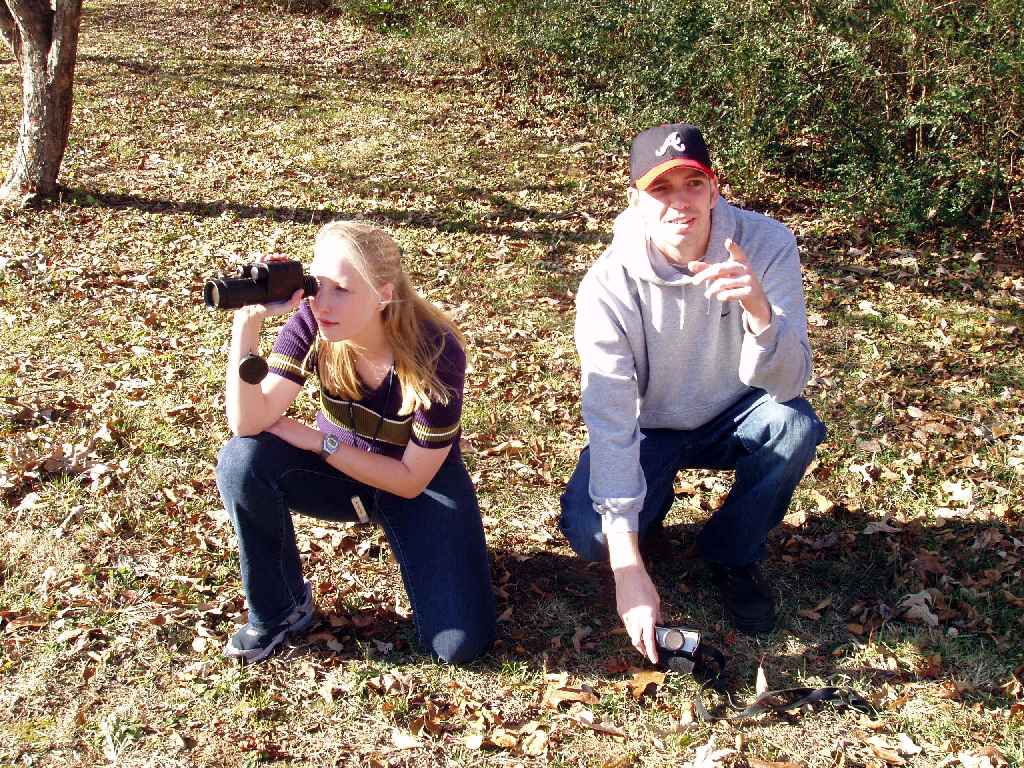Fall 2005
By: Trista Bouland and Amy Krzton-Presson

Abstract
Agriculture has a major effect on wildlife habitat degradation and fragmentation. Our main objective was to compare the species richness between two different types of corridors, each running through agricultural areas. We used track beds to determine the number of species moving through both types of corridors. We baited with apples, peanut butter, and canned cat food and recorded all mammal signs found on or around our sites each day for six days. Our statistical analysis, an unpaired t-test, showed no significant difference between the average species diversity between the two types of sites. Because of this, we had to accept our null hypothesis.
By: Sarah Bullock and Courtney Thomason
Abstract
Roads and highways tend to fragment the established habitats of wild animals, and fragmentation can often disrupt travel within these habitats. We examined the frequency of visitations of carnivores and omnivores at road-side and interior scent stations to determine possible effects of road and highway interference with travel patterns of these mammals. We placed two motion sensitive cameras at half mile intervals along Mulberry Flat Road in Land Between the Lakes National Recreation Area to record the presence of target species. We used three scents: gland scent, curiosity scent, and food scent to attract the species. The stations were checked after two full days, and results were recorded. We found two animals at road-side stations and two at interior stations. A paired t-test suggests there is no significant difference between sightings at interior or road-side stations. We believe more research is needed to determine if a significant difference does exist.
By: Jared B. Handley
Abstract
Since the mammals being captured in Sherman Live Traps have small body sizes, their metabolic rates are among the highest of any mammals (Lewis 2001). In order for these smaller mammals to reach their high energy needs they are expected to use optimal-foraging strategies (Lewis 2001). In an experiment done by Lewis et al. (on food selection) it was determined that Peromyscus leucopus rapidly perceived differences in energy and protein contents in foods A<>lthough a great deal of research has been done on food preferences, not much research has been done on food preferences related to predation risks. To do this, high and low quality foods were used in three different habitats (representing different risks of predation). The objective for this experiment was to answer the question: will the animals increase their risk of predation to obtain higher quality foods? The alternative hypothesis was: the animals will increase their risk of predation to obtain higher quality foods.
By: Jessica Shaw and Sarah Loecken
Abstract
The golden mouse (Ochrotomys nuttalli) can be found in early and mid successional habitats in temperate regions of North America where suitable microhabitat requirements are met (Morzillo et al. 2003). These are characterized by dense areas of woody vines, and saplings (Morzillo et al. 2003). Golden mice are known for their especially arboreal habits including the construction of arboreal nests and using vines as pathways to and from their destinations. As more areas become fragmented by humans it is important to examine the effects it may have on the ways animals use their altered habitats. We predicted the recent tree clearing of a transect through thick early successional habitat will require the golden mice in that area to become more arboreal and select more arboreal nest sites, thus changing the interactions with their habitat.. Golden mice were trapped at a disturbed site and an undisturbed site in Calloway County, KY from September 2005 to November 2005. Arboreal indicies, tree traps, observations, tracking, and number of arboreal nests, were used to classify how arboreal the mice were in each area. Vegetation maps of each site were created showing the habitat used within the possible home range of the two mice tracked. Unfortunately the sample size (n=2) limited the types of analyses which could be conducted on this data and no conclusions could be developed about a difference in arboreal activity between the two sites.
Mammalian diversity research has not been conducted at Clarks River National Wildlife Refuge. Our main objective was to determine species diversity found in areas of the refuge with different management practices. Four different habitats (fallow field, native warm season grass field, wildflower field, and woods) were tested to attempt to determine the different species that inhabit each type of habitat. Thirty Sherman traps were placed in each area to sample the small mammals that were in the area. One digital motion trail camera was also placed in each area in attempt to sample the large mammals in the area. A significant difference was found between the fallow field and both the native warm season grass field and the wildflower field (p-value=.0213). No significant difference was found when comparing the number of species caught and the other types of habitats.
By: Drew Logsdon and Mark Sandfoss
There are few research studies focused on the bait preference of small mammals in regards to native and exotic baits. We studied the preference of small mammals to enter traps baited with native seeds against those baited with exotic seeds. The baits were comprised of native warm season grasses Little Bluestem (Schizachyrium scoparium), Big Bluestem (Andropogon gerardii), Switchgrass (Panicum virgatum), Sideoats Grama (Bouteloua curtipendula), and Indian Grass (Sorghastrum nutans) for the native bait and exotic forbs and grasses (Kobe Lespedeza: Lespedeza striata var. kobe and Tall fescue: Festuca arundinacea) for the exotic bait. The baits were placed in two traps perpendicular to rodent runways found within our study areas. There were 176 trap nights with 21 captures during the study. The study areas consisted of a disturbed recently planted warm season grass 10-acre field, a Natural Resources Conservation Service warm season grass demonstration field established for a year, and a planted walnut grove. The field study areas were located on nearby Clarks River National Wildlife Refuge while the third area was in Lexington, Kentucky. The results of the study gave a p-value of 0.1942, which was above our 0.05 preset alpha level. Therefore, there is no scientific justification for a preference to be placed on native or exotic bait. The results could be strengthened with a larger sample size and greater number of captured species.
Fight, Flight, or Subterfuge: Defensive Strategies of Didelphis virginiana.
By: Mark Roberts
It is well known that a defensive strategy employed by Didelphis virginiana is a paralysis response, commonly known as “playing possum”. How frequently is this strategy chosen over fight or flight, which are common defenses employed by many species? I captured 11 D. virginiana and made observations on defensive strategies employed at three stages: initial contact upon removal from the cage, intermediate as designated by a change in strategy from initial response (if there was one), and final response prior to being released. I found that flight was the most frequently observed response in both initial and final stages, while paralysis response was the most common during the intermediate stage.
By: Stacey Campbell and Jodie Jones

Advancements in technology have definitely provided children with the opportunity to expand their knowledge. However, children are missing out on the opportunities to experience hands-on activities when it comes to environmental sciences. Children’s decreased interest in environmental issues has already been noted, and schools have started to implement nature trails into their school yards. One of these schools is Heath Elementary School in West Paducah, Kentucky, which is where our project took place. A nature trail was established in the spring of 2005, but final touches and enhancement was needed and welcomed by Lisa Alvey, the science teacher at the school. Our project goal was to incorporate different aspects of environmental science. We accomplished this by using several diverse techniques such as trapping, game cameras, planting and identifying trees, constructing study specimens, and tracking tubes. These techniques and several more helped us reach not just the kids, but the whole community. Because of our enhancement efforts, attendance has increased at the trail, and children are expressing more concern for nature. The trail has become so successful that Heath Elementary is up for the Gold Certificate award from the KY Department of Fish and Wildlife, and other schools are asking for our assistance with environmental education.
By: Tiffany Hedrick and Benjamin Pierce

We examined whether the benefits for bats of feeding in lighted areas (abundant night-flying insects acting erratically) outweigh the costs of human disturbance in Murray, Kentucky. Ten similar field sample sites were selected (5 artificially lighted and 5 unlit). In each, bat activity was monitored using the Anabat II detector for 30 minutes per night over 2 or 3 nights. All data were collected within 2.5 hours after sunset in temperatures above 12.8 ºC. The number of minutes with bat activity was used as an index of overall activity. This value was then weighted based on the number of nights of data from that site and analyzed in Microsoft Excel using a student’s t-test. Analysis showed that the average activity for the artificially lighted sites was significantly larger than in the unlit sites, indicating that the benefits for bats of feeding in lighted areas do outweigh the costs.